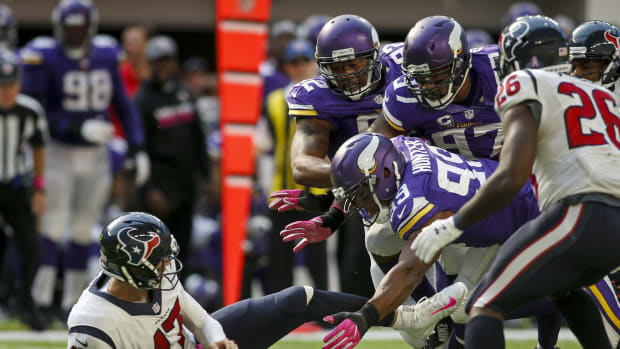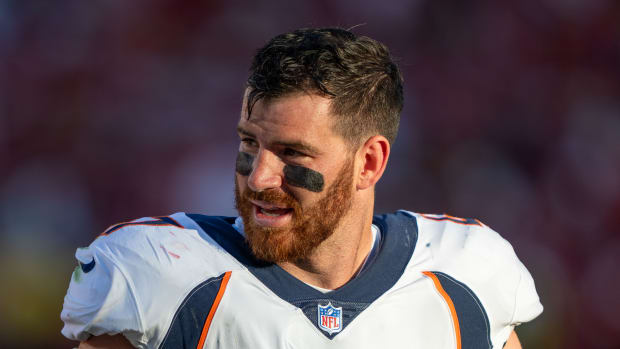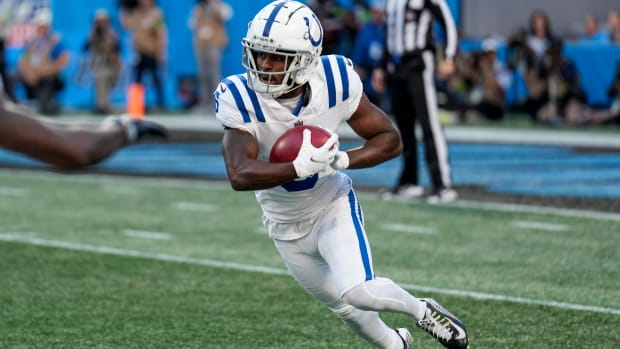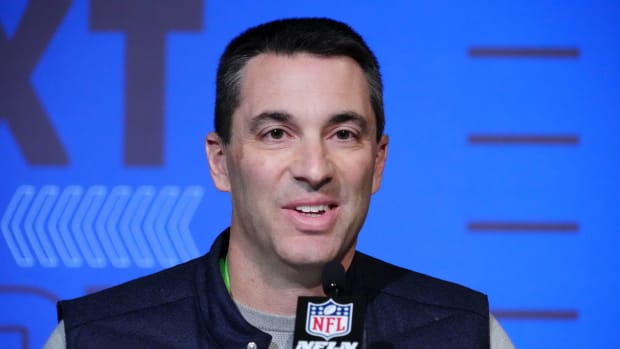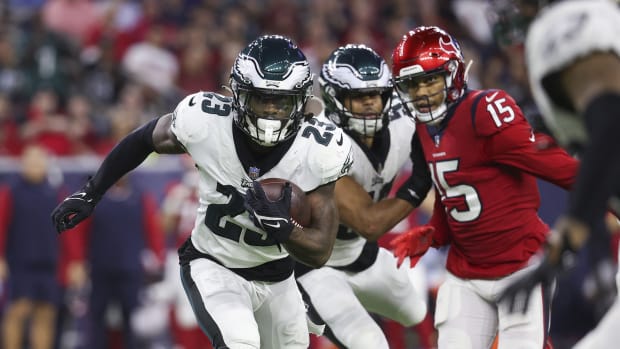GamePlan: Raheem Morris Won’t Have to Wait Long for His Next Chance
Raheem Morris could complain, and the Rams defensive coordinator would probably have a receptive audience for his gripes. It’s been just over 10 years since the Buccaneers fired him, and he’s done just about everything possible to build himself back up into the kind of head-coaching candidate anyone would want to hire.
He’s coached offense. He’s coached defense. He’s even had a run as an interim head coach.
More than just that, he’s had time to look in the mirror and evaluate what went wrong for him the first time around, when he got his first shot at 32 and was let go at 35.
But early on this warm Southern California morning, Morris wasn’t going to do that. Even if Morris still has all the qualities that made him such a bright young candidate in 2009, the football mind and irrepressible energy that prompted the Bucs to promote their secondary coach to defensive coordinator, then to head coach in one fell swoop. And even if Morris has gained so much knowledge and wisdom since then.
“It’s actually weird, because I don’t really think about it,” Morris said over the phone, from the team facility in Thousand Oaks. “I always thought of myself to be fortunate in any way to be anything in this league. … You never really take that for granted, you just look at the opportunities you’ve gotten, look at the opportunities that you’ve had. And I’ve been fortunate enough to have three interviews since I was fired.
“So I never really thought about it being so long because I don’t take that for granted. I think it’s an honor and a privilege to be a head coach in the National Football League. Those times, those moments will come. I got fortunate enough to have them when I was young. But I never take that for granted. Or take it for granted that it was going to happen again or that I was going to have another opportunity soon enough.”
Accordingly, as the sun rose Thursday, Morris was looking forward to getting on the grass with Aaron Donald, Jalen Ramsey, Leonard Floyd and Von Miller at the Rose Bowl. He was looking forward to fine-tuning a game plan to get after Joe Burrow and the Bengals. He was looking forward to coaching in the Super Bowl down the road at SoFi Stadium.
And even if he won’t say it, it’s obvious he should have a lot more to look forward to.
It’s Super Bowl Friday, and that means the GamePlan is packing a punch this week. Inside the column, you’ll find …
• How scouts see Super Bowl LVI.
• A peek at the ever-evolving quarterback landscape.
• Who’ll win the game …
• … and who will have the most on the line in the process.
But we’re starting with the story of the Rams defensive coordinator, who’s building momentum towards his second shot as an NFL head coach.
It’s easy to forget that at one point, Morris was actually 4–2, and coming off a 10–6 season in Tampa. The Buccaneers, at that point, in October 2011, were coming off a win over Sean Payton’s Saints and heading to London to play the Bears. And the organization looked prescient in having hired Morris to replace Jon Gruden two years earlier.
Little did anyone know that Morris had won his last game with the team.
The Bucs turned the ball over five times, with Josh Freeman throwing four picks, in that game against Chicago, and it was the first 10 straight losses to end a 4–12 season that culminated in Morris’s firing. In retrospect, though he lasted a little longer, it wasn’t unlike Josh McDaniels’s in Denver—both guys were hired at 32 in 2009. Both showed early signs of promise. Both, for different reasons, also wound up showing their inexperience.
“It was just a different deal, man,” Morris said. “Your maturity level and your football level just grow at a certain rate that lets you know that you're ready for that next step and ready to get back into that seat. And I think it’s really helped me throughout the process. I can’t look back on anything and [erase] mistakes, but I can look back and learn a lot of lessons from the things that happened throughout the whole process and how it works.
“It wasn’t all bad. We had that successful year, we went 10–6. We were 4–2, leading the division at the time. And stuff collapsed and didn't go as well as you like it to go, and ultimately we’re here now.”
Morris is here now a different dude. He was 35 then; he’s 45 now. He was single then; he’s married with three kids now. And as a football coach, his only experience at the NFL level then was on the defensive side and in Jon Gruden’s program. He now has experiences, both good and not so good, that have made him far more well-rounded than he was when the Bucs pulled the plug on him in early January 2012.
Moreover, the lessons he’s gotten have come from people he’s been connected to along the way. His first job post-Tampa was in D.C. under Mike Shanahan, to whom Morris was connected by Kyle Shanahan—he and the younger Shanahan worked closely together as Bucs assistants in 2004 and ’05, coaching the DBs and receivers, respectively. Then, he worked for Dan Quinn, who was on staff at Hofstra when Morris played there. And last year, it was another old Bucs and Washington assistant, Sean McVay, hiring him.
He’s seen those guys evolve. He’s evolved with them, and in a bunch of different ways.
In Washington, Morris saw the elder Shanahan run a program. And most of all, Morris saw the two-time Super Bowl champion’s fingerprints on every piece of the football team there, even if things didn’t end the way everyone wanted in 2013. “His patience, his ability to sit in different rooms and learn from everybody, and also to have some input and add real value to all aspects of our game,” Morris said, “I thought that was really cool.”
In short, Morris got a look at how, while Shanahan has so commonly been seen as an offensive guru, his impact on the roster was total. And that motivated Morris to keep being, as he puts it, “nosy” about what was happening in offense. So just as he’d trade notes with Kyle Shanahan back in Tampa, when the younger Shanahan wanted the finer points of the Tampa-2 defense, Morris now was being intentional about huddling with a wildly talented, young Washington offensive staff.
“Going to Washington really helped me get around those guys on offense,” Morris said. “Sean McVay and Kyle Shanahan and Mike Shanahan and Matt LaFleur and Mike McDaniel, you sit in those rooms and do a bunch of cross-training with those guys from an offensive standpoint, you learn. That’s where it really got started from, the across-the-hall kinda thing for me with offense, defense and special teams.”
Having worked with Jon for all those years in Tampa, Morris was retained by Jay Gruden after Shanahan was fired in 2014, and seeing Gruden lead the program at a different tempo helped round out his first experience back as an assistant. But maybe most valuable was the chance he got to help with McVay’s transition to becoming a coordinator that year.
“We could sit down and talk just about everything—football, calling a game, what we’re doing to plan it, how we’re going to plan it,” Morris said. “And then you think about people first, and some of those things that he has here, with the we-not-me mentality, all that started when he was a coordinator at Washington.”
And going to Atlanta with Quinn thereafter only bolstered what he took from McVay’s ability to connect with the whole offense. Morris got to Atlanta in 2015, on the ground floor of Quinn’s Falcons program, and its foundation was laid in the relationships that Quinn pushed his coaches to build.
“I got the brotherhood stuff from Q—those experiences bringing a team together, talking about the guys being a player-led team, and how to help those guys, being confident in those guys, really helping these guys grow,” Morris said. “And nobody cares about their players as much as Q. That really helps you when you gotta dig and take guys as far as you can take them when you’re really a big part of that program, you’re one of the pillars as an assistant head coach.”
From there, with a trip to the Super Bowl mixed in, two more tangible things happened for Morris. The first came in January 2016, after the Falcons lost receivers coach Terry Robiskie, who was hired away to be Titans' offensive coordinator.
Morris had told Quinn that more than just a great receivers coach, he needed to hire one that Kyle Shanahan, who’d also gone with Quinn to Atlanta, would trust, and respect, and be able to bounce stuff off of. Quinn gave Morris a few names to vet, and a few calls to make, and Morris started setting interviews before Quinn came back to him.
Hey, I thought about this for a while. How about you?
Shocked, Morris told Quinn he’d have to ask Shanahan about it. And a few days later, Morris wasn’t just named the receivers coach, he became the pass-game coordinator under Quinn and Shanahan, too. That gave him the chance not only to diversify his résumé, but also to do the one thing that every defensive coach who becomes a head coach has to do: He’d learn to work with and manage the most important position on the field.
“It was the daily interaction with the quarterback,” he said. “You coach wideouts but essentially, you become the sounding board for what Matt Ryan is trying to get done across the board to those wideouts, why it's important, what’s important. You can detail those things for your quarterback, and that allows you to form a better relationship with those guys. And once you get a relationship with the quarterback, that touches the whole team.
“That guy, we always say they’re the most important person on the team, but they are. They touch the O-line, they touch the wideouts, they touch the running backs, they touch the ball every single play. They're the people that you gotta get things orchestrated through.”
So Morris did that for a year under Shanahan, then under Steve Sarkisian and Dirk Koetter before moving back to defense in 2020. And while that didn’t go as planned—Quinn and GM Thomas Dimitroff didn’t make it through October—the second tangible thing happened for Morris.
He got to be a head coach again, if with the interim tag. For 11 games, he got to run the whole team and, maybe most importantly, he got to work with an interim GM, in Ruston Webster, who’d been a GM before.
“I know we had the interim title but we certainly didn’t act like there was an interim title,” he said. “It was full-on, full-blown, ‘Raheem, what’s the decision? How decisive can we be in this crisis management?’ And we’re in a pandemic. And all the lessons learned just from that alone got me back into the mode, with the lessons learned from that just let you know, ‘Hey, this is what you want to do, this is how you want to do it.’
“And you just can’t wait to get your next opportunity.”
That opportunity didn’t come in 2021—the Falcons did interview him, as did the Jaguars, after the ’20 season—but a new one did. And that put him where he is now, back with McVay in L.A.
Here, he’s gotten the shot to work with all those stars on defense. He’s seen how McVay works with GM Les Snead and COO Kevin Demoff (“It's unique, the communication level between our COO, our general manager and our head coach, and it just spills throughout the building”). And he also had to adjust once again.
McVay wanted to keep the bones of the Vic Fangio–styled scheme that Brandon Staley put in the year before, and that meant, for Morris, moving closer to what his players knew, rather than making his players meet him where he’d always been schematically. Therein lay another lesson.
“Why make everybody learn my language when one person can learn their language?” Morris said. “Football is football. And I wanted to put myself in position like I was here the year before. So I wanted to do everything as if I was here, from a cut-up standpoint, from a detail standpoint, from an assignment standpoint, all the stuff that we do as far as coaching. So I was able to do all those things, and then once I was able to move past [learning it], they put me almost as if I was here the year before.
“And it allowed me to have a better perspective on where to go and what to do next and how we get better and how we look at it.”
Which feels like, to those who’ve worked with him in the Rams organization, just more finish on a guy who’s much more complete coach than he once was, and one that should be attractive to everyone a year from now.
There’s one overarching lesson Morris has learned, too, from all those places he’s been—whether it was watching things crumble in Washington, getting to a Super Bowl in Atlanta, seeing things crumble again there, and finally getting back to the Super Bowl here—and that’s the importance of communication.
For Morris, being a good communicator has never been a problem. What has been is how intentional a communicator he is.
Watch NFL games online all season long with fuboTV: Start with a 7-day free trial!
That may seem like a subtle difference, but it’s not. He’ll admit now that his communication with GM Mark Dominik in Tampa wasn’t good enough, nor was the communication with other parts of the organization. He saw it affect teams in Washington and Atlanta, too, and now he’s seeing how it facilitates a thriving operation in Los Angeles.
It’s not just coach to GM, and vice versa, either—it’s coach-to-everyone. Morris even cited the synergy McVay and Rams head trainer Reggie Scott work with as an example.
“Everybody’s flying straight and flying the same at all times,” Morris said. “I think that’s how you come back in crisis management. It’s like the issue we had struggling down the stretch [in Tampa] and trying to find a way to get a win and we just couldn't do it. I didn't feel like we were all on the same page.
“And I felt like here, this year, going through a three-game losing streak here, things were made consistent. I felt like the messaging remained the same, I felt like we just handled things better. … More people turned inward.”
So whenever Morris’s next chance comes, that lesson’s as big as any he’s taken looking back a decade, and drawing from everything he’s been through since.
And, again, he swears he’s not getting himself worked up over the fact that he had only one interview this year—even if his colleagues were stunned and upset that was the case. But that doesn’t mean his goal isn’t there, and clear.
At some point, he absolutely wants to put all he’s learned to work.
“The bug has never gone away,” he said, laughing. “There is nothing like being a head coach, nothing like being in charge, the good and the bad, because there's nothing like being able to evaluate yourself that way. Those are the things that drive me—moving people, leading people, all the things that you want to do. So I cannot wait for the next opportunity.
“With all that being said, I'm extremely happy with my role, I'm extremely happy with what I'm doing and I'm extremely happy with my development and how far I've been able to come since the first time I had an opportunity.”
He shouldn’t have to wait much longer for the next one.
FIVE STAR MATCHUPS
To get you ready for Sunday, I hit up a couple scouting buddies who work primarily on the pro side during the year. And here’s what I came up with for key matchups heading into LVI.
1) Jalen Ramsey vs. the Bengals' receivers. The question here really is whether the Rams put Ramsey on Ja’Marr Chase, or double Chase and assign Ramsey elsewhere. “I think the hidden matchup is Tee Higgins,” said one NFC exec. “He could be a difference-maker for the Bengals. With his size and length, there’s only one corner on the Rams who can match up with him and that’s Ramsey. Some teams have put their No. 1 corner on Tee, and doubled Chase. But then you better have a plan for Tyler Boyd and C.J. Uzomah.” In other words, there’s an edge here for Cincinnati, and there should be matchups for Joe Burrow to find.
2) Mike Hilton vs. Cooper Kupp. This is another one that’ll have across-the-board implications. “I’m really anxious to see how the Bengals use Mike Hilton,” said a second NFC exec. “How much is he on Kupp? Do they use him blitzing? You figure they’ll use him as a disruptor—that’s how we saw him as a free agent, we thought he was a gadget player like Tyrann Mathieu, who can do a bunch of things.” To be sure, Hilton’s been a star in the playoffs. And he may be the best slot corner in football. Which means using him the right way should be vital to how the Bengals defense plays.
3) Matthew Stafford vs. the Bengals' secondary. Now, this is an interesting one. The expectation our first exec had? That Bengals DC Lou Anarumo would try to make the Rams win with a death-by-a-thousand-papercuts approach. “I wanna see how patient the Bengals defense is going to force Stafford to be,” he said. “I really think they’ll make him take the checkdowns, and take away the shots, because the Rams offense has been so predicated on explosives.” Our second exec agreed with that, adding, “Bad Stafford could come out and turn the ball over” if the Bengals make him go on longer drives to get to the end zone.
4) The Bengals' offensive line vs. the Rams' defensive front. This is, and has been, the story all week—Can the Bengals block the Rams? The right side of Cincinnati’s offensive line is where you should watch for mismatches, especially with rookie Jackson Carman banged up. “I wanna see if the Bengals can put up a fight against that pass rush,” the second exec said. “The Tennessee game should’ve been a bloodbath. And now you have a shaky offensive line potentially missing a shaky player that’s starting for them. It’s hard to envision they won’t have issues up front.”
5) Bengals LB Logan Wilson vs. Rams RB Cam Akers. And this really is about the Rams’ wide-zone run game against a rangy, under-appreciated group of Cincinnati linebackers. “The Bengals linebackers are pretty fast, pretty athletic, they can run and chase the ball,” the second exec said. “It’s a good matchup for them maybe not to shut them down completely, but hold up against the Rams’ run game. The same structure they played against Kansas City should serve them well here.”
FOUR THINGS TO FOLLOW
The tide sure feels like it’s turning on Washington. On Wednesday during his annual Super Bowl press conference, NFL commissioner Roger Goodell offered this up when he was asked whether owners had the power to take another owner’s team away: “I do believe the clubs have the authority to remove an owner from the league. Ultimately, it's a league vote, I believe.” Goodell then said that NFL general counsel Jeff Pash would be able to confirm that. So I asked Pash, and he did. Now, the statement came during a line of questioning concerning Dolphins owner Stephen Ross. But so many questions had come down on the Washington investigation by that point that Goodell knew full well who he was putting in the crosshairs—Commanders owner Dan Snyder. And that was driven home by the fact that he dismissed out-of-hand the idea that Washington would be able to conduct an independent investigation into Snyder’s alleged transgressions. “I do not see any way that a team can do its own investigation of itself,” Goodell said. “That’s something that we would do. We would do it with an outside expert that would be able to help us come to the conclusion of what the facts were and what really, truly happened so that we can make the right decision from there.” Now, we may still be a ways out from the other owners pushing Snyder out (Ross’s situation is different, since his is centered on a single allegation). Bottom line, owners generally want to avoid the precedent of a team being seized in this fashion. But that Goodell was willing to speak as openly as he did, and seeing his tone change from the October meetings when the Washington situation was festering, tells me that the tide might be turning here. Stay tuned.
The Russell Wilson and Aaron Rodgers dominoes. This offseason has potential for a lot of quarterback movement—but so much of it will likely be dictated by what happens at the highest level, and specifically whether Rodgers and Wilson get antsy again and try to join Deshaun Watson on the trade block. If Rodgers and Wilson stay put, and Watson settles the lawsuits against him, then the Texans will be positioned to get a lot for their 26-year-old franchise quarterback (we’ll have more on this Monday, but the way Lovie Smith is talking about Davis Mills tells me that Houston will be all ears on Watson from the jump this time around). If the other two try and escape Green Bay and Seattle, on the other hand, the landscape gets a little more complex. And the quarterbacks on the next level down, players like Jimmy Garoppolo could have their opportunities to start elsewhere affected by what happens with the elite as well. The reason why I’m raising this obvious question now? Look at the calendar. Last year, it was Feb. 9 when Wilson made his appearance on the Dan Patrick Show—and revealed that he thought Seattle had fielded trade calls on him. Nine days before that, the Rams and Lions had agreed to the Matthew Stafford trade. And in the week leading up to the Stafford trade, the Rodgers situation was ignited by Rodgers himself ruminating over an uncertain future after losing the NFC title game, then doubling down on the thought on the Pat McAfee Show two days later. Which is to say we’re already behind last year’s chaos, so pieces are likely to start moving soon (and maybe within the Super Bowl weekend news cycle).
While we’re there, it’s worth considering what might push a team to take a quarterback out of a shaky draft pool in April. Namely, money. If you take a hard look, a few teams that, on paper, could look for an upgrade at the position will likely be hard-pressed to do so this weekend, given their cap situation. The two best examples are the Vikings and Titans. Kirk Cousins has a $45 million cap number, and his base salary of $35 million for 2022 is fully guaranteed. Ditto for Ryan Tannehill, with a $38.6 million cap number, and fully guaranteed base of $29 million for next year. Carson Wentz’s logistics put the Colts in a similar spot, with a $28.29 million cap number, and $15 million of his $22 million base for 2022 fully guaranteed. And even Sam Darnold’s situation in Carolina merits watching—the team has his fully-guaranteed $18.858 million fifth-year option to contend with. In each of these cases, the quarterback’s outsized number, at the very least, gives the team a roadblock to work around if it wants to upgrade at quarterback, like the Rams and Niners did last year. Now, the Rams were in a similar situation with Jared Goff, and got the Lions to take his contract off their hands (paying a draft-pick tax to make that happen). Personally, I think it’ll be tough to get another team to do something similar with one of the aforementioned four. And that might have those four teams looking towards a draft class that’s been panned by just about every scout I’ve spoken to, since the options there would be far more financially feasible.
Rules change proposals come soon, and will be discussed at the combine, and that means overtime will come up again. I know speaking to people involved that they expect a few different ideas to come from teams to ruminate on—remember, last year, the Ravens brought forward the spot-and-choose proposal, and Bill Belichick has raised the full-period idea on multiple occasions (that’s one I like). Now, I’d warn anyone getting their hopes up that these things can sometimes take years to go from the idea phase to actually being voted through. But there should be, at the very least, some interesting conversation in the six weeks left between now and the league’s annual meeting, during which these things are voted on.
TWO BEST BETS
(Season record: 22–20. It’s been a long journey, but this is probably what keeps people gambling—I started 4–12 and rallied for a winning season. So you know, we’re only counting the pick against the spread here, which guarantees I’m over .500. Why only that? Because that’s what I decided … and it’s what I’ve been picking all year.)
Bengals (+3.5) over Rams: The line has come down this week a full point, and it still fits my pick on the site—which was a 27–24 Rams win/Bengals cover scenario. What scenario would change my mind? If Joe Burrow has the ball last …
Over 48.5: As you can see, I have it right around the number, at 51 total points. I see a game where the defenses stand tall through three quarters, then run out of gas a little at the end.
ONE BIG QUESTION
Who has the most on the line this week?
I’ve been asked this a lot this week—I think it’s Stafford. Why? It’s actually pretty simple.
The context of his 13 years in Detroit will change completely with a win on Sunday. And if you really drill down on the facts of his time as a Lion, you’ll see that too. Check it out …
• He’s one of eight quarterbacks to throw for 5,000 yards in a 16-game season, doing it at 23 years old in 2011. And he came within 33 yards of repeating that feat in 2012, at a time when few were coming close to it.
• The Lions were in a decade-long playoff drought and coming off the NFL’s first-ever 0–16 season when he was drafted in 2009. He got the Lions to the playoffs three times in the next eight years, under two different coaches.
• The last quarterback to get Detroit to the playoffs three times was Bobby Layne, who was my dad’s favorite player as a kid. Those playoff appearances all happened before my dad’s eighth birthday.
• Stafford’s the team’s all-time leader—by a wide margin—in completions, attempts, yards and touchdown passes. He had nearly three times as many passing yards as any other Lion quarterback when he left Detroit, and more than two times as many touchdown passes.
So what does all of that mean? To me, it’s a little like Tom Brady winning a Super Bowl in his first year out of New England. Fair or not, it sure seemed to add a lot context to his 20 years as a Patriot, and make him seem even more responsible for all the success his teams had there.
In this case, if Stafford’s raising the Lombardi Trophy on Sunday, it’d be pretty easy to draw the conclusion that he, too, may have been a little under-appreciated in his previous home, where he accomplished a lot in the face of some challenging circumstances.
More NFL Coverage:
• The Legend Behind Joe Burrow’s Cigar Celebrations
• SoFi Stadium Went Up—and Then Everything Changed
• He Pledged to Live on the Roof During a Bengals Losing Streak
• The Long, Strange Relationship Between the Super Bowl and Hollywood
Sports Illustrated may receive compensation for some links to products and services on this website.






































